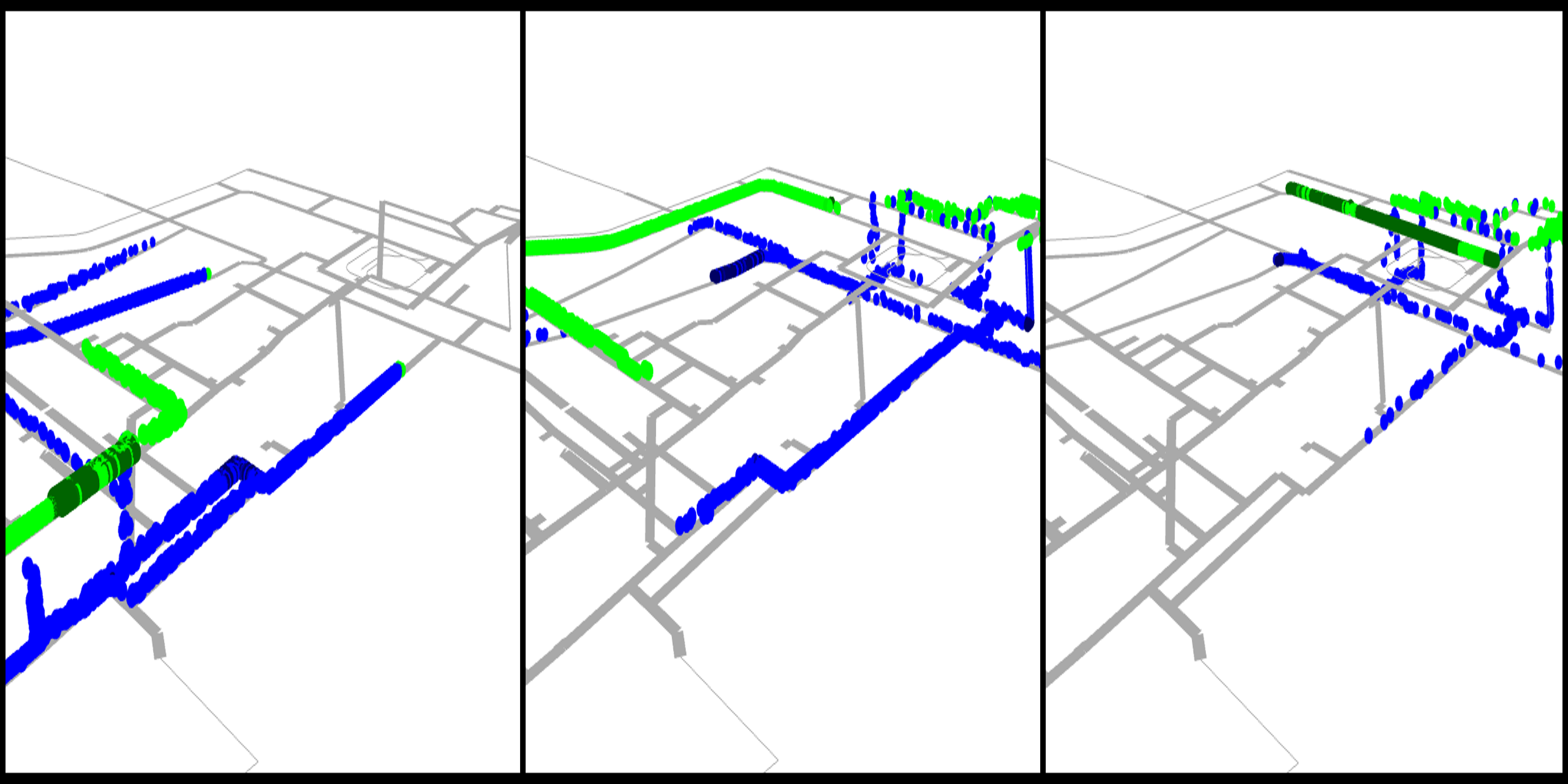Effectiveness Verification of Evacuation Guidance Including Underground Passages Using Multi-objective Optimization
DOI:
https://doi.org/10.17815/CD.2024.174Keywords:
Multi-agent simulation, Evacuation guidance, Multi-objective optimizationAbstract
In this study, we approach the optimization problem of evacuation guidance assuming major terminal stations in Tokyo using crowd simulation and optimization algorithms. We propose a method to optimize multiple indicators with various guidance variables, including underground passages, and evaluate multiple scenarios obtained through optimization. The results of experiments using three algorithms: Random search, NSGA-II, and MOTPE, showed that MOTPE can be used to search for high-quality solutions quickly. Additionally, scenarios with guidance shortened the total evacuation time and reduced the congestion levels compared to scenario without guidance.
References
Zhang, P., et al.: Development value and future trend of urban underground street. Current Urban Studies 7(01), 20 (2019)
Qin, J., Liu, C., Huang, Q.: Simulation on fire emergency evacuation in special subway station based on pathfinder. Case Studies in Thermal Engineering 21, 100677 (2020)
Chen, Y., Wang, C., Yap, J.B.H., Li, H., Zhang, S.: Emergency evacuation simulation at starting connection of cross-sea bridge: Case study on haicang avenue subway station in xiamen rail transit line. Journal of Building Engineering 29, 101163 (2020)
Nakasaka, Y., Ishigaki, T.: Vulnerability to mega underground inundation and evacuation assuming devastating urban flood. Journal of Disaster Research 16(3), 321-328 (2021)
Hou, J., Chen, G., Zhang, Y., Li, B., Yang, S., Tong, Y., Zhang, D., Fu, D.: A simulation study on risks of pedestrian evacuation from flooded staircases of different slopes in the underground space. Natural hazards 110(1), 519-543 (2022)
Zhu, Y., Chen, T., Ding, N., Chraibi, M., Fan, W.C.: Follow the evacuation signs or surrounding people during building evacuation, an experimental study. Physica A: Statistical Mechanics and its Applications 560, 125156 (2020)
Galea, E., Xie, H., Deere, S., Cooney, D., Filippidis, L.: An international survey and full-scale evacuation trial demonstrating the effectiveness of the active dynamic signage system concept. Fire and Materials 41(5), 493-513 (2017)
Wang, J., Jin, B., Li, J., Chen, F., Wang, Z., Sun, J.: Method for guiding crowd evacuation at exit: The buffer zone. Safety science 118, 88-95 (2019)
Chen, S., Fu, L., Fang, J., Yang, P.: The effect of obstacle layouts on pedestrian flow in corridors: An experimental study. Physica A: Statistical Mechanics and its Applications 534, 122333 (2019)
Wang, X., Shen, L., Shi, S.: Evaluation of underground space perception: A user-perspective investigation. Tunnelling and Underground Space Technology 131, 104822 (2023)
Deb, K., Pratap, A., Agarwal, S., Meyarivan, T.: A fast and elitist multiobjective genetic algorithm: NSGA-II. IEEE Transactions on Evolutionary Computation 6(2), 182-197 (2002)
Ozaki, Y., Tanigaki, Y., Watanabe, S., Onishi, M.: Multiobjective tree-structured parzen estimator for computationally expensive optimization problems. In: Proceedings of the 2020 genetic and evolutionary computation conference, pp. 533-541 (2020)
Bergstra, J., Yamins, D., Cox, D.: Making a science of model search: Hyperparameter optimization in hundreds of dimensions for vision architectures. In: International Conference on Machine Learning, PMLR, pp. 115-123 (2013)
Yamashita, T., Okada, T., Noda, I.: Implementation of simulation environment for exhaustive analysis of huge-scale pedestrian flow. SICE Journal of Control, Measurement, and System Integration 6(2), 137-146 (2013)
Fruin, J.J.: Designing for pedestrians: a level-of-service concept. Highway Research Record (1971). URL https://api.semanticscholar.org/CorpusID:112610444
Lee, E.H., Christopoulos, G.I., Kwok, K.W., Roberts, A.C., Soh, C.K.: A psychosocial approach to understanding underground spaces. Frontiers in psychology 8, 452 (2017)
Akiba, T., Sano, S., Yanase, T., Ohta, T., Koyama, M.: Optuna: A next-generation hyperparameter optimization framework. In: ACM SIGKDD International Conference on Knowledge Discovery & Data Mining, pp. 2623-2631 (2019)
Zitzler, E., Thiele, L.: Multiobjective optimization using evolutionary algorithms — a comparative case study. In: International Conference on Parallel Problem Solving from Nature, pp. 292-301 (1998)
Brockhoff, D., Friedrich, T., Neumann, F.: Analyzing hypervolume indicator based algorithms. In: International Conference on Parallel Problem Solving from Nature, pp. 651-660 (2008)
Liang, J., Zhu, X., Yue, C., Li, Z., Qu, B.Y.: Performance analysis on knee point selection methods for multi-objective sparse optimization problems. In: 2018 IEEE congress on evolutionary computation (CEC), pp. 1-8 (2018)

Downloads
Published
How to Cite
Issue
Section
Categories
License
Copyright (c) 2024 Mei Takeda, Masaki Onishi

This work is licensed under a Creative Commons Attribution 4.0 International License.
Authors contributing to Collective Dynamics agree to publish their articles under the Creative Commons Attribution 4.0 license.
This license allows:
Share — copy and redistribute the material in any medium or format
Adapt — remix, transform, and build upon the material
for any purpose, even commercially.
The licensor cannot revoke these freedoms as long as you follow the license terms.
Authors retain copyright of their work. They are permitted and encouraged to post items submitted to Collective Dynamics on personal or institutional websites and repositories, prior to and after publication (while providing the bibliographic details of that publication).








